Mexico Vacation: Sun, Sand and Drug Trafficking
At the very eastern end of the U.S.-Mexico border, there’s a long strip of sand where the Rio Grande meets the sea. It is called Playa Bagdad or ‘Bagdad Beach.’
Unlike the Tijuana-Imperial Beach border on the western end, where no steel pilings are marching out to sea to stop migrants from swimming, wading or paddling across to the United States.
In Playa Bagdad, which is spelled ‘Playa Baghdad’ by the Drug Enforcement Agency, it’s apparently unnecessary: This is a beach for drugs and crime, not migrants.
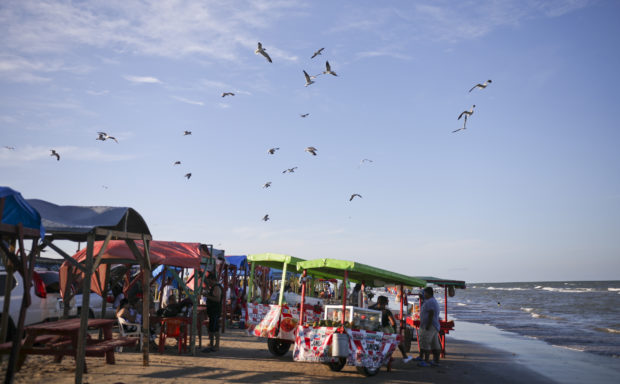
In this Aug. 2, 2019 photo, seagulls fly over food trucks in Playa Bagdad close to the mouth of the Rio Grande, near the border city of Matamoros, Mexico. Unlike the Tijuana-Imperial beach border, on the western end, where there are no steel pilings marching out to sea, to stop migrants from swimming, wading or paddling across to the United States. (AP Photo/Emilio Espejel)
As attention focuses on the migrant crisis along the border that has drawn harsh rhetoric and actions from President Donald Trump, Playa Bagdad seems to have escaped notice.
Here, there are no walls or border guards, just miles of dunes and Gulf coast beaches marked only by simple wooden huts or awnings held up by sticks.
The only highway ends abruptly in a handful of structures populated by beachgoers looking for alcohol and fishermen who might catch sharks one day and unload cocaine the next.
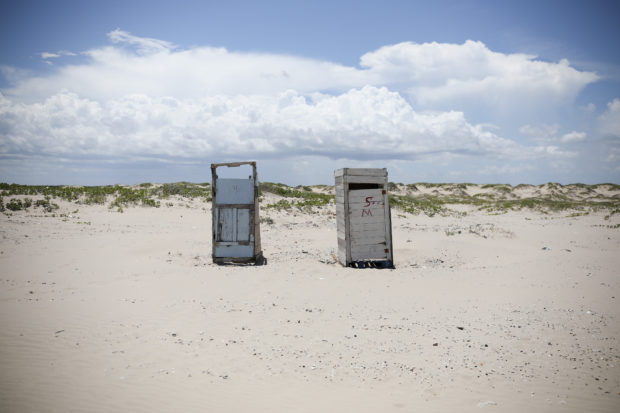
In this Aug. 3, 2019 photo, two public restrooms dot the landscape on Playa Bagdad near the border city of Matamoros, Mexico. The last thing the drug cartels want is to draw U.S. patrols to the area, which is already hard to reach by any normal route. It is precisely that remoteness and lack of patrols that serve the drug trade, the economic activity that has become the mainstay here. (AP Photo/Emilio Espejel)
On the U.S. side, there is not much more besides a single Customs and Border Protection checkpoint, a gun store complete with a shooting range, and a SpaceX hangar where some rockets that might reach Mars are being tested. The nearest city of Brownsville, Texas is 25 miles (40 kilometers) away.
Where the two countries meet lies an expanse of water perhaps 25 yards (23 meters) wide, so shallow that you could walk across at low tide, but few people do.
The reason it’s kept under wraps is simple: Cartels tend to use these coastal plains for purposes like transporting drugs or as the DEA notes, dumping bodies clandestinely. And they put a premium at keeping migrants away.
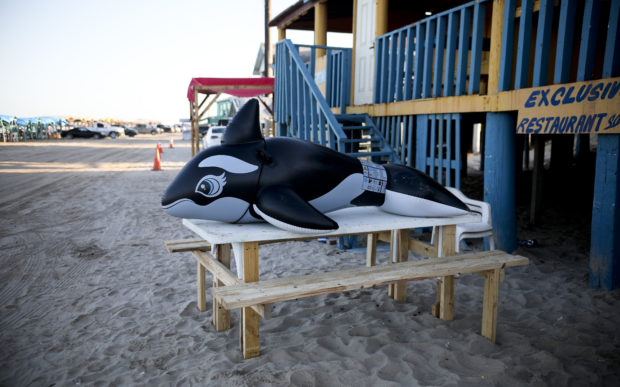
In this Aug. 2, 2019 photo, a plastic inflatable whale sits on a picnic table in Playa Bagdad close to the mouth of the Rio Grande near the border city of Matamoros, Mexico. As attention focuses on the migrant crisis along the border that has drawn the stepped-up measures by President Donald Trump, Playa Bagdad seems to have escaped notice. (AP Photo/Emilio Espejel)
“They want to keep the heat off this spot,” said Marco Antonio Alvarez, a rail-thin old man with a greying beard and leather-like skin toughened by the sun.
Alvarez, who spent time in U.S. jails for migrant smuggling, says he still gets paid $300 per month he won’t say by whom to watch the expanse of water and two boats.
“If people start crossing the river, you start seeing (CBP) patrol vehicles show up on the other side,” said Alvarez, who usually sits sheltered from the sun in the shade of an old plywood camper that once served as a seafood stand.
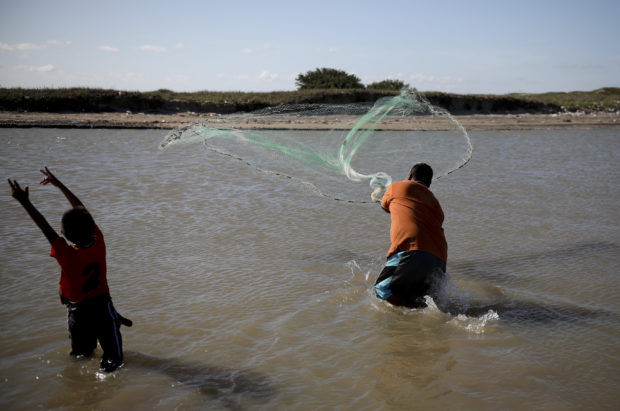
In this Aug. 2, 2019 photo, local tourists fish in the waters of Playa Bagdad near the border city of Matamoros, Mexico. Besides fishing, contraband has always been here in one form or another: silver, or alcohol during Prohibition. In the 1980s and 90s, marijuana and Colombian cocaine. (AP Photo/Emilio Espejel)
Playa Bagdad appeared on maps in 1848, when the border was drawn during the Mexico-American War. Later, it became the seaport for cotton produced in Texas during the Civil War.
The origin of the settlement’s name is lost to the annals of history. A ship might have run aground and been looted there, a scene that might have reminded some of the “Ali Baba and the 40 Thieves.” Or the person who named it might have been a fan of “The 1,001 and Nights.”
Mike Vigil, a former DEA operation chief, remembered one story which maintains that the U.S. Army might have stationed some camels at Playa Bagdad during its experiments with those animals in the 19th century.
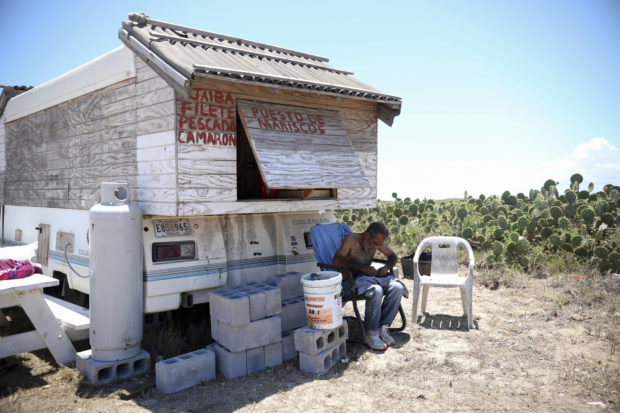
In this Aug. 3, 2019 photo, Marco Antonio Alvarez, 55, mends his shirt as he sits sheltered from the sun in the shade of an old plywood camper that once served as a seafood stand, near the shoreline of Playa Bagdad, Mexico. He has spent time in U.S. jails for migrant and drug smuggling. Now he gets paid $300 per month to watch the river and the two boats pulled up on the bank. (AP Photo/Emilio Espejel)
But contraband has always been here in one form or another. Centuries back, silver was trafficked through. During Prohibition, alcohol could be procured. And in the 1980s and 1990s, it was marijuana and Colombian cocaine that made its way across.
DEA Special Agent Sammy Parks said Playa Bagdad is now a center for loading and unloading drugs bound for the U.S. market.
“It is a short, easy route without much law enforcement,” added Vigil.
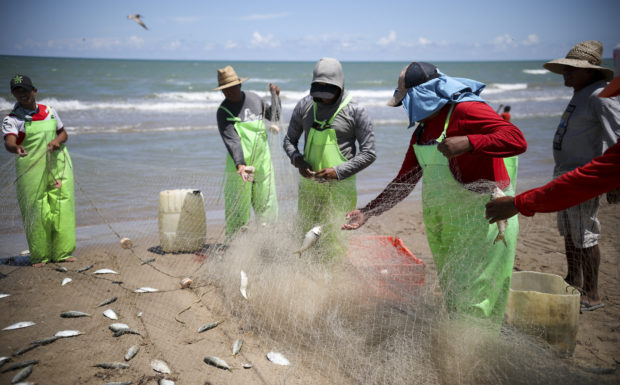
In this Aug. 3, 2019 photo, fishermen remove their catch from their nets at Playa Bagdad near the border city of Matamoros, Mexico. The origin of the town name Bagdad is lost in the mists of history. (AP Photo/Emilio Espejel)
Of the 1,215 members of the National Guard that Mexico has deployed to Tamaulipas, none are seen in Playa Bagdad. They are mainly in the conflictive border cities further west along the Rio Grande Valley.
Three decades ago, people like Alvarez combined fishing with small-scale migrant smuggling, guiding people across to Brownsville for $20 per head. That all ended in the 1980s and 1990s.
“When they started to sell crack, you couldn’t do business anymore because everything was controlled by the mafia,” Alvarez said.
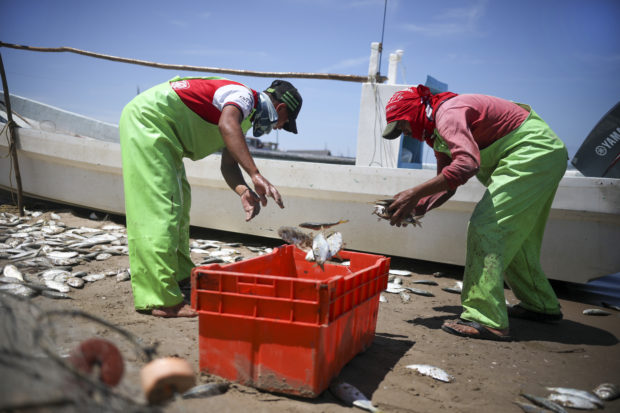
In this Aug. 3, 2019 photo, fishermen collect their catch at Playa Bagdad beach near the border city of Matamoros, Mexico. Three decades ago, some residents combined fishing with small-scale migrant smuggling, guiding people across and to Brownsville for $20 per head. (AP Photo/Emilio Espejel)
The city of Matamoros, whose territory covers Playa Bagdad, touts the beach as a great tourist destination.
But Alvarez said that drug cartels completely control it.
“You have to pay them a quota and get their permission,” he notes.
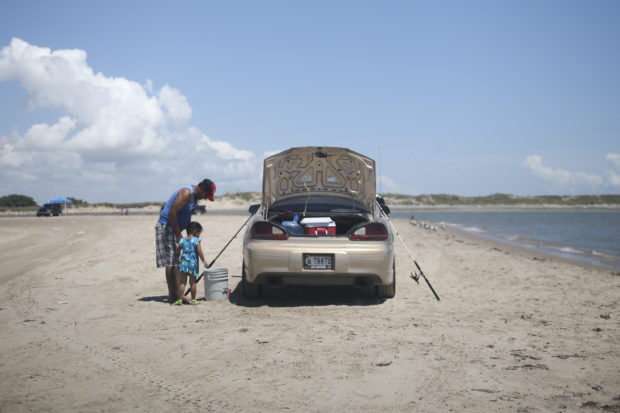
In this Aug. 3, 2019 photo, a child watches a grown-up clean a fish during a fishing trip to Playa Bagdad near the border city of Matamoros, Mexico. Playa Bagdad appeared on maps in 1848, when the border was drawn during the Mexico-American War. (AP Photo/Emilio Espejel)
For years, the violent state of Tamaulipas, where Playa Bagdad is located, has been ruled by silence and fear, and the state government itself is suspected of having been infiltrated by drug gangs, with two former governors currently on trial on corruption charges.
One of the key drug-cartels operating in the area is the now-splintered Gulf Cartel.
In 2000, the Gulf Cartel’s armed enforcement wing, The Zetas, split and began an all-out offensive.
The Zetas later split themselves again, but still control the westernmost part of the state, while the Gulf Cartel has also splintered and controls the east.
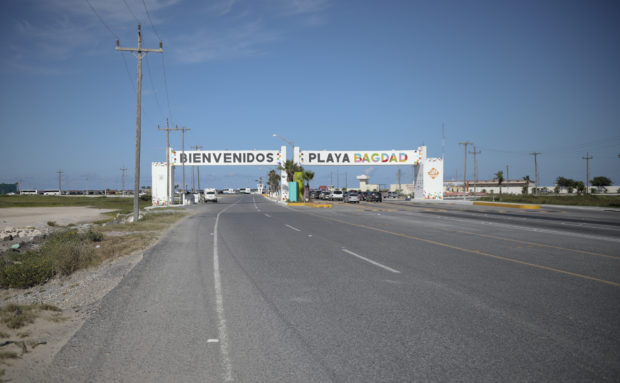
This Aug. 3, 2019 photo shows an entrance welcoming travelers to Playa Bagdad near the border city of Matamoros, Mexico. DEA Special Agent Sammy Parks said Playa Bagdad is a center for loading and unloading drugs bound for the U.S. market. It is a short, easy route without much law enforcement. (AP Photo/Emilio Espejel)
The federal government did not respond to requests for comment, although the current state government headed by an opposition-party governor says it is actively collaborating with U.S. and Mexican federal authorities to combat cartels, often by sharing information.
These days though, the only law enforcement The Associated Press saw were four state police officers who rode through quickly on two ATVS and just as quickly left.
According to the DEA, small fishing boats load drugs in Playa Bagdad and run it up the coast to Padre Island, in Texas.
Other boats are known to drop off goods which are then loaded onto vehicles and taken into the U.S. by the highway.
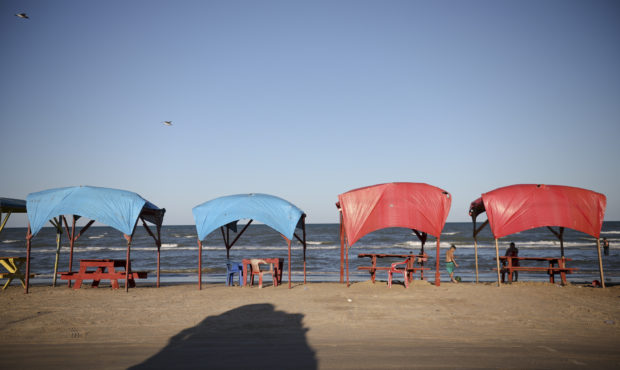
In this Aug. 2, 2019 photo, picnic tables shaded by tarps line the shoreline in Playa Bagdad close to the mouth of the Rio Grande near the border city of Matamoros, Mexico. The only highway that reaches here ends abruptly in a handful of huts populated by beachgoers looking for alcohol and fishermen who might catch sharks one day, and unload cocaine the next. (AP Photo/Emilio Espejel)
Some of the border crossings themselves are under de facto cartel control on the Mexican side.
One man who was fishing with friends at the mouth of the Rio Grande recalled seeing a would-be border crosser who cartel gunmen brought back from the river between the two countries at gunpoint.
“They pointed guns at him and brought him back,” he said. “If you want to cross, it is with them.”
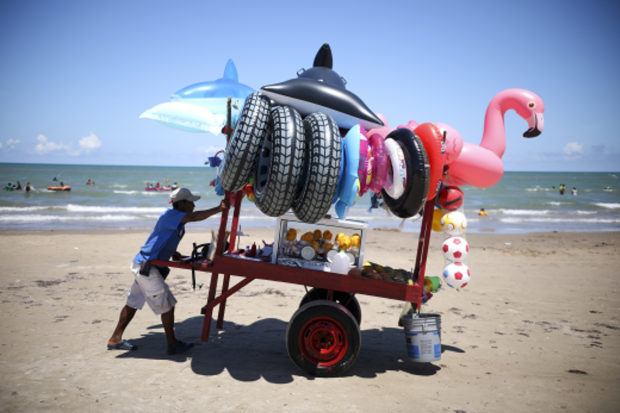
In this Aug. 3, 2019 photo, a vendor pushes his cart equipped with inflatable pool toys and fruit cups along the shoreline of Playa Bagdad near the border city of Matamoros, Mexico. Locals view it as a place where it is best to keep out of trouble. (AP Photo/Emilio Espejel)
He was one of the few who were willing to talk, and even then, the conversation died down every time a boat passed.
“You never know who is listening,” said the man, declining to give his name.
There are more than 6,000 disappeared persons in Tamaulipas alone.
“Mass graves have been discovered in the Playa Baghdad area, and there’s a local threat about being ‘taken to the beach,’ which implies someone will disappear,” said Parks, the DEA agent.
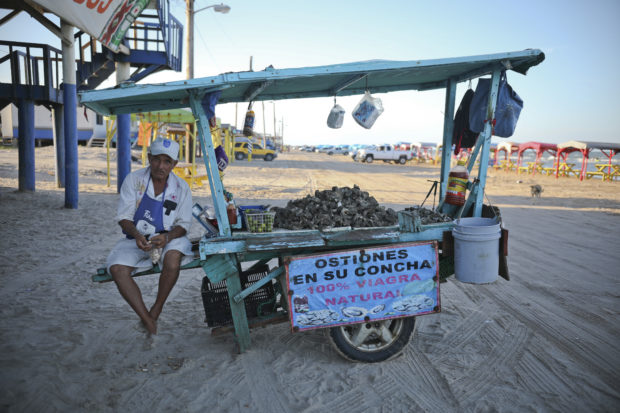
In this Aug. 2, 2019 photo, an oyster vendor snacks on shelled peanuts while he waits for customers in Playa Bagdad near the border city of Matamoros, Mexico. Here, the landscape is not one of the walls or border guards; it is simply miles of dunes and Gulf coast beaches, marked only by simple wooden huts or awnings held up by sticks. (AP Photo/Emilio Espejel)
The only official presence is a sandbag guard post on the highway between Playa Bagdad and Matamoros, although locals protested at the post this month, saying it was only used to demand bribes.
For Alvarez, “the Guard” doesn’t mean President Andrés Manuel López Obrador’s National Guard either.
Instead, it means “former soldiers, marines, and police who report to the gangs.”
Further down the coast in the hamlet of Playa Bagdad, there is a lively scene. Small seafood restaurants stand on stilts and the sound of mariachi music mixes with the shouts of vendors selling oysters. A marine guard post offered some semblance of protection to tourists.
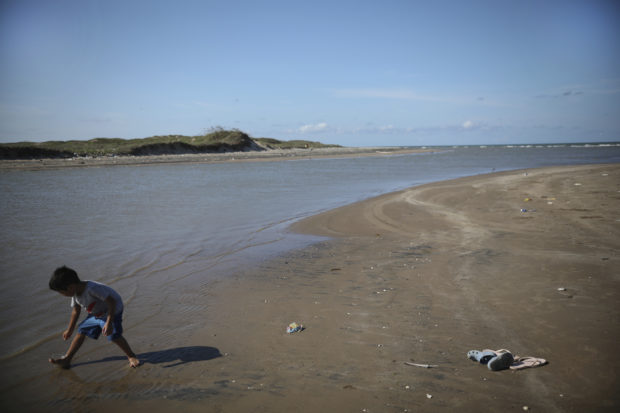
In this Aug. 2, 2019 photo, a child collects seashells as he walks along the shoreline in Playa Bagdad close to the mouth of the Rio Grande where between the U.S. and Mexico lies an expanse of water, perhaps 25 yards (meters) wide, so shallow that you can walk across at low tide, but few people do. (AP Photo/Emilio Espejel)
Then, a big man with close-cropped hair descended from a truck selling roast chickens to ask what journalists were doing in the area.
“As tourists, you can film whatever you want,” the man said, emphasizing the word tourists and suggesting anybody else should get out.
“Here there is freedom of expression.”

